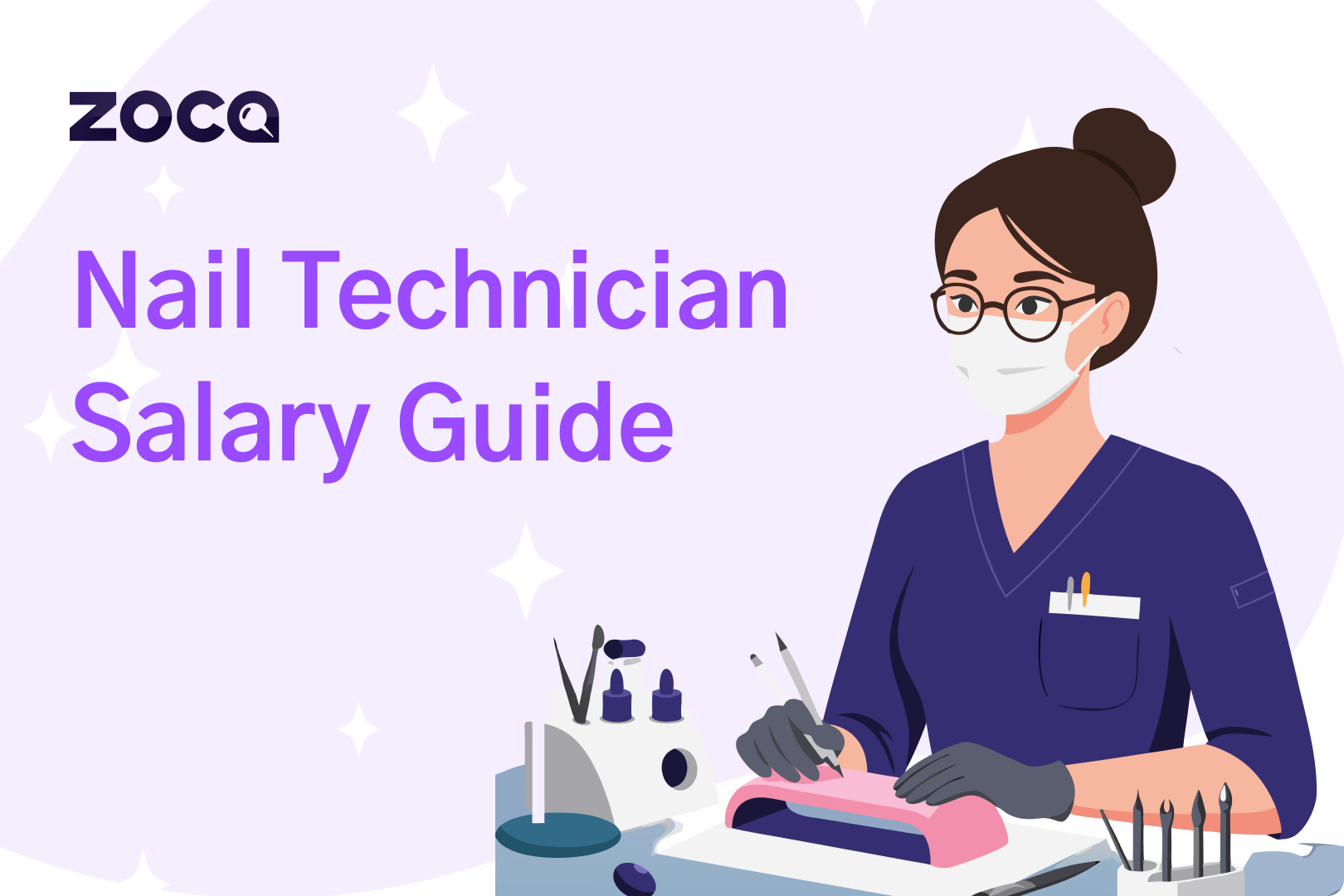The transformation I've witnessed in my regular nail tech, Leila, still amazes me. Two years ago, she was the newest hire, nervously offering me water while checking her empty appointment book.
Now she owns the chair by the window and turns clients away. When I asked about her salary journey, her candid answer shocked me: "First year was poverty wages. Now I make more than my husband, who has a master's degree."
Fascinated, I spent weeks combing through nail tech forums and industry statistics data, even grilling my friend who manages a salon chain. The contrast between national averages and what successful techs quietly confided online was eye-opening.
This guide merges official data with real-world experiences to show you the actual financial path from nervous newbie to booked-solid professional.
Nail Technician Salary - National Average
Nail technicians across the United States earn a wide range of salaries, with pay often varying significantly depending on the state in which they work.
The table below provides a comprehensive overview of average hourly and monthly wages for nail technicians in different states across the US, offering insight into regional differences and helping job seekers, employers, and industry professionals better understand current compensation trends.
Nail Technician Income Ranges by Experience Level
Let me tell you, the income journey for nail techs isn’t just about numbers; it’s a real-life rollercoaster, with moments of doubt, hustle, and those big “I made it!” milestones. If you ask around, every nail technician has a story: the struggle of those first few slow months, the pride of booking out back-to-back appointments, and the thrill of finally being able to set your own prices. The path from rookie to seasoned pro is rarely a straight line, but the rewards grow as your skills and confidence do.
Here’s a look at what you can actually expect to earn at each stage, with insights pulled from techs sharing their unfiltered stories online and in the salon breakroom. You might see yourself somewhere in this journey or find inspiration for what’s possible next.
Just Starting Out: 0-2 years - $1,600-3,200/month
For newbies just starting out, it's pretty rough. Most are making somewhere around $400-800 a week, often working weird hours or just weekends. One person mentioned barely clearing minimum wage plus some measly tips while building their client base.
Another talked about working Saturdays only and making just enough to cover their booth rent. It's that awkward phase where you're slow, still learning, and haven't built a loyal following yet.
Getting the Hang of It: 2-5 years - $2,400-4,800/month
Once you've got a couple of years under your belt, things start looking up. The sweet spot appears to be the 2-5 year range, where techs are earning $600-1200 weekly. I noticed several people mentioning they were making about $1500 every two weeks, working 4-day weeks. Not bad! By this point, they've usually got regulars, work faster, and know how to upsell.
Seasoned Pros: 5+ years - $4,000-7,200/month
The veterans (5+ years in) who've stuck with it can pull some serious cash. These are the folks mentioning $1000-1800 weekly incomes, though practically everyone mentioned slow seasons where they might drop to $800 or less. One tech who'd been at it for 5+ years was super honest about the fluctuations, saying she makes anywhere from $800 to $ 1500 depending on whether it's wedding season or post-holiday slump.
The Top Shelf: 5+ years with specialization - $6,000-10,000/month
The real ballers are the ones who've either gone independent or found a premium salon in a wealthy area. There's that one tech who casually dropped that she made "roughly 70k" her first year after leaving a salon job. Another mentioned "$250 a day" as if it were just a normal Tuesday.
Honestly, though, these top earners are definitely not the norm from what I could gather. They're the ones who've really hustled, built Instagram followings, or landed in salons where rich clients don't blink at $150 nail sets.
Nail Technician Compensation Structures (Commission vs. Booth Rental)
The nail industry offers two main compensation models with different financial structures:
There's a big difference between being an employee and an independent contractor.
- Independent contractors control when they work, what services they offer, and what they charge.
- Employees on commission should get certain protections, like minimum wage guarantees and overtime.
Your success with either option really depends on your local market, your skills, and whether you can build a loyal client base.
Factors Affecting Nail Technician Salary
Now that we've seen what nail techs make on average, let's get into what really affects your paycheck in this industry – because there's a huge difference between struggling at $30K and crushing it at $60K+.
1. Location Impact
Where you work plays a huge role in what you'll earn as a nail tech. Big cities pay more, but living costs eat up those gains. Smart techs often target affluent suburbs, finding a sweet spot between high-end clients and reasonable expenses.
2. Specialization and Skill Development
If you ever want to know what sets apart the nail techs who fill their books months in advance from the ones still hustling for walk-ins, it almost always comes down to one thing: specialization. I remember chatting with a tech who once dreaded painting French tips; now she’s famous in town for her intricate 3D nail art, booked out by clients who drive an hour just for her signature looks.
Learning the basics keeps you afloat. But the moment you pick up a new technique, whether it’s sculpted acrylics, gel extensions, or those viral chrome finishes, your income potential jumps. The more you master your skills, the more confidence you inspire in your clients. Suddenly, you’re the go-to for wedding nails or the person everyone tags for those jaw-dropping designs online.
Every nail tech’s journey is different, but investing in skill development isn’t just about making more money; it’s about finding your creative niche, building a reputation, and loving what you do. The clients (and the bigger paydays) will follow.
3. Schedule and Hours
Most full-timers put in 30-40 hours weekly, with the money flowing in:
- Thursday through Saturday (when everyone wants appointments)
- Early mornings and after work hours
- Wedding season and holidays
The pros maximize high-demand times and work efficiently. Being able to do quality work 15-30% faster makes a huge difference to your hourly rate.
4. Regional Considerations
The money breakdown by region:
- West Coast: $43,681/year
- Northeast: $44,060/year
- Midwest: $41,297/year
- South: $38,162/year
Canadian provinces mostly hover around $33,030/year, according to the data.
Always weigh potential earnings against how much it costs to live somewhere before making big moves!
Physical and Health Considerations
Nail work puts a major strain on your body. You'll spend 6-8 hours daily hunched over your hands, making tiny repetitive movements with your fingers and wrists. Without proper setup, expect neck, shoulder, and back pain to become regular companions.
Chemical exposure is another daily reality - acrylic products contain harsh chemicals linked to breathing problems, skin irritation, and headaches. Even "safer" gel systems emit vapors during UV curing.
Preventive Measures
Smart protection strategies include:
- Investing in an adjustable ergonomic chair ($250-400) that keeps your back properly aligned
- Installing proper ventilation with extraction units near your workspace ($500-2000)
- Taking quick 5-minute stretch breaks between clients (scheduling these is non-negotiable!)
- Wearing masks rated for chemical particulates, not just surgical or cloth masks
- Using low-toxicity product lines despite their higher cost
- Setting hard limits on daily service hours (no more than 5-6 hours of actual nail work)
- Positioning your workstation so clients' hands rest at elbow height, not higher
Long-Term Career Sustainability
The physical toll means smart techs limit direct service to 25-30 hours weekly, build in recovery days, and gradually shift some income toward teaching or consulting. Many successful technicians add complementary services requiring different movements to give overused muscle groups a break. The goal is variety - doing the exact same motion hundreds of times weekly guarantees problems.
Financial Planning for Health
Self-employment means budgeting for your own healthcare. Set aside 10-15% of income for medical costs and potential work absences. Independent contractors rarely qualify for disability coverage, making emergency savings crucial. Health insurance that covers massage, physical therapy, and chiropractic care can pay off tremendously in this field.
Focus on Reducing Burnout with Salon Management
Modern booking systems can enforce proper spacing between appointments, preventing the back-to-back scheduling that ruins your body. Digital management tools allow tracking service duration and automatically build in recovery periods.
The best salons implement rotation systems where technicians alternate between intensive services (extensions) and lighter work (quick color changes) to distribute physical strain throughout the day.
Closing Note
This nail industry really gives you options that most careers don't. You can work part-time while raising kids, hustle hard to stack cash when you need it, or build your own mini-empire. What I love about the field is seeing techs in their 50s and 60s who've adapted their business as their lives changed – switching from high-volume salon work to specialized services with fewer clients but higher prices.
The physical challenges are real, but with smart self-care and business choices, you can build something that fits your life, not the other way around. The skills pay the bills, but the freedom to design your own path? That's priceless.
Best of luck from Zoca!
FAQs
1. How much does nail school typically cost?
Nail technology programs range from $3,000 to $10,000, depending on location and program comprehensiveness. Many schools offer payment plans or partial scholarships.
2. How long does it take to build a full client book?
Most new techs need 6-12 months to build a stable clientele. Consistency, social media presence, and referral incentives can accelerate this timeline.
3. What's the biggest mistake new nail techs make?
Underpricing services. Many beginners charge too little, which makes it difficult to cover expenses and creates problems when they eventually need to raise prices.
4. Should I start with commission or booth rental?
Commission is generally better for beginners - you'll get built-in clients, supplies, and mentorship while learning the business aspects without immediate overhead costs.
5. How many clients can an experienced tech handle daily?
Most efficient techs handle 5-7 clients daily for full services or 8-10 for simpler services, balancing income with physical wellbeing.
6. Is location or skill more important for earnings?
Both matter significantly, but exceptional skill can overcome average location through higher prices and client willingness to travel for quality work.
Zoca follows up, replies instantly, and secures bookings while you focus on your craft.



